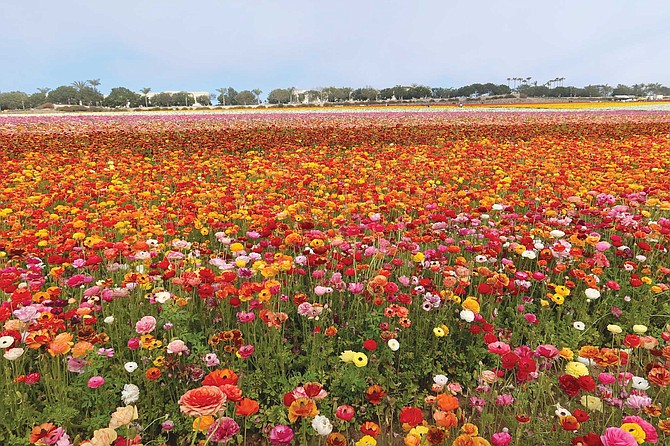 Facebook
Facebook
 X
X
 Instagram
Instagram
 TikTok
TikTok
 Youtube
Youtube

The famed Flower Fields of Carlsbad are among the few local attractions that have actually gotten better with time. The zoo? Natural-habitat-mania has put many of the animals out of sight. Sea World? Overrun with roller-coasters and other thrill rides. But the 55-acre Flower Fields remain a tranquil and beautiful celebration of the blooming world.

The heart of the Flower Fields is, of course, the array of vast sloping fields of Giant Tecolote ranunculus. These natives of Asia Minor belonging the buttercup family, bloom each year in the springtime, generally from March through May. Take a tram, or a hike, up the slope to its eastern rim and you can gaze out over expansive patches of color that seem to sink into the Pacific Ocean. There are trails throughout the ranunculus, along with little inlets where you can gather friends and family members for amazing photos, surrounded by vibrant, multicolored blossoms.
The origin of the Flower Fields dates back to the early 1920s, when early settler and horticulturalist Luther Gage planted a bunch of ranunculus seeds in his fields next to Frank Frazee’s vegetable farm in South Oceanside. In 1933, Frazee also began growing ranunculus and, with son Edwin, soon mastered the art of seeding, cultivating and irrigating the flower. In 1965, the younger Frazee, who by then had taken over the operation, moved his ranunculus to the current site, owned by the flower-growing Ecke family of Encinitas. (They had previously used the fields to grow their poinsettias before moving them into greenhouses.) The Flower Fields soon became a popular visitor attraction, but it wasn’t until a 1999 agreement with Armstrong Garden Centers to manage a retail store and nursery that the groundwork for the present operation was laid. Since then, there have been continual improvements, with more to come.
“That’s kind of been our motto since I started,” says Fred Clarke, who has managed the Flower Fields for the Eckes for nearly 25 years. “Before, it was a farm; we were about selling flowers, and we just kind of added on the tourism thing. Then it grew on us, and we realized the Flower Fields really transform people in the way they feel and the way they experience their day when they’re on site. There’s a magnetic pull of the flowers that elevates your mood.”
Once your mood has been sufficiently elevated, you can mosey down below and find a bustle of activity, including a sweet pea maze, tractor-pulled wagon rides, greenhouses for poinsettias and orchids, and a whimsical butterfly garden. There’s also a “demonstration garden,” established and tended to by Master Gardeners of San Diego County, with nine botanical vignettes consisting of native plants, proteas, meadow grasses, and a pollinator bed. For kids, there’s a playground — with original structures imported from Santa’s Village, the iconic theme park in Lake Arrowhead that closed more than 20 years ago — and a gold mining “camp” where young miners can find polished gemstones by sluicing water through boxes of sand, just as Gold Rush miners a century and a half ago used to do in creek beds in northern California and nearby Julian. But all that is secondary, like a water slide next to Niagara Falls — or a roller coaster at Sea World. The real attraction here is the enduring yet ephemeral beauty of that broad and brilliant petaled patchwork.


The famed Flower Fields of Carlsbad are among the few local attractions that have actually gotten better with time. The zoo? Natural-habitat-mania has put many of the animals out of sight. Sea World? Overrun with roller-coasters and other thrill rides. But the 55-acre Flower Fields remain a tranquil and beautiful celebration of the blooming world.

The heart of the Flower Fields is, of course, the array of vast sloping fields of Giant Tecolote ranunculus. These natives of Asia Minor belonging the buttercup family, bloom each year in the springtime, generally from March through May. Take a tram, or a hike, up the slope to its eastern rim and you can gaze out over expansive patches of color that seem to sink into the Pacific Ocean. There are trails throughout the ranunculus, along with little inlets where you can gather friends and family members for amazing photos, surrounded by vibrant, multicolored blossoms.
The origin of the Flower Fields dates back to the early 1920s, when early settler and horticulturalist Luther Gage planted a bunch of ranunculus seeds in his fields next to Frank Frazee’s vegetable farm in South Oceanside. In 1933, Frazee also began growing ranunculus and, with son Edwin, soon mastered the art of seeding, cultivating and irrigating the flower. In 1965, the younger Frazee, who by then had taken over the operation, moved his ranunculus to the current site, owned by the flower-growing Ecke family of Encinitas. (They had previously used the fields to grow their poinsettias before moving them into greenhouses.) The Flower Fields soon became a popular visitor attraction, but it wasn’t until a 1999 agreement with Armstrong Garden Centers to manage a retail store and nursery that the groundwork for the present operation was laid. Since then, there have been continual improvements, with more to come.
“That’s kind of been our motto since I started,” says Fred Clarke, who has managed the Flower Fields for the Eckes for nearly 25 years. “Before, it was a farm; we were about selling flowers, and we just kind of added on the tourism thing. Then it grew on us, and we realized the Flower Fields really transform people in the way they feel and the way they experience their day when they’re on site. There’s a magnetic pull of the flowers that elevates your mood.”
Once your mood has been sufficiently elevated, you can mosey down below and find a bustle of activity, including a sweet pea maze, tractor-pulled wagon rides, greenhouses for poinsettias and orchids, and a whimsical butterfly garden. There’s also a “demonstration garden,” established and tended to by Master Gardeners of San Diego County, with nine botanical vignettes consisting of native plants, proteas, meadow grasses, and a pollinator bed. For kids, there’s a playground — with original structures imported from Santa’s Village, the iconic theme park in Lake Arrowhead that closed more than 20 years ago — and a gold mining “camp” where young miners can find polished gemstones by sluicing water through boxes of sand, just as Gold Rush miners a century and a half ago used to do in creek beds in northern California and nearby Julian. But all that is secondary, like a water slide next to Niagara Falls — or a roller coaster at Sea World. The real attraction here is the enduring yet ephemeral beauty of that broad and brilliant petaled patchwork.
Comments